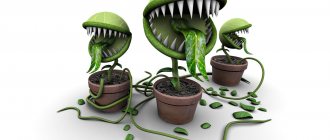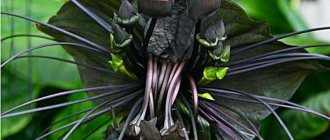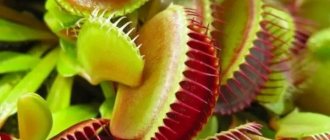Many plants found in the home are poisonous to cats.
Caring for a cat involves not only making healthy food choices and regular visits to the vet, but also making sure your home is completely safe for your cat. An inquisitive pet will search everywhere and willingly try plants that may be poisonous to him. Read our article to find out which plants should not be within reach of your little friend. We'll also tell you which safe indoor plants can brighten up your home.
Poisonous plants for cats - what symptoms occur after ingestion?
Potted plants make a home feel cozier and the layout more interesting. However, visual considerations are not the most important thing, especially if you have a cat - it turns out that flowers can be very harmful to your pet. Do you think that your cat is not interested in plants, so they can be left out of the house? This is incorrect thinking because for some plant species, just trying a small amount once is enough to cause irreversible changes in the small organism.
Poisoning from toxic plants causes drooling, diarrhea, lethargy, abdominal pain, lack of appetite, seizures and even death. A bite from the plant may cause immediate symptoms or lead to poisoning only after some time. Dangerous plants cause the cat’s kidneys to work worse and worse, and the heart has an abnormal rhythm. Therefore, do not take risks and check all the plants that you have at home, and in this way you will protect your pet from poisoning.
Symptoms of toxic plant poisoning:
- salivation,
- diarrhea,
- abdominal pain
- lack of appetite
- convulsions,
- no desire to play
- kidney or liver weakness
- acceleration or deceleration of heart rate.
Some indoor and garden plants are very poisonous to cats.
Schlumbergera bridgesii
A genus of epiphytic cacti from Brazil. The second name is Christmas cactus or Decembrist. Known for their bright red flowers that bloom around the Christmas holidays.
These are not desert cacti, they love water. If cared for properly, the Christmas cactus can live for 20-30 years and makes a red holiday gift.
Tips for caring for a flower
- Lighting:
Adaptable, but prefers diffused light simulating tropical forest conditions. - Watering:
Water once a week. - Soil:
Light, permeable to water. Drainage.
Lilies are poisonous plants for cats
Poisonous plants are those that you know well, you like their smell, and you watch them grow on your windowsill. One of the most poisonous flowers for pets are flowers of the lily family , which are highly toxic and, interestingly, can cause unpleasant symptoms not only in animals, but also in people. If the lily is part of a bouquet decorating your home and you have a cat, discard this dangerous decoration. Both petals and stamens or stems, and even fine pollen, are toxic to these flowers.
Lilies are highly nephrotoxic, meaning they destroy the kidneys. In addition to the usual symptoms that may occur with poisoning, your cat may become thirsty. This will not escape your attention, because wallets rarely end up in a bowl of water. By nature, they do not drink much, but rather eat water from their food. After eating any part of the lily, you may experience abdominal pain due to enlargement of the kidneys.
- The lily family is harmful to cats because it is nephrotoxic. Kidney problems may occur after eating the petals, stamens, stems or pollen because every part of the lily is toxic.
Beautiful lilies that decorate home windowsills and gardens can become dangerous if they are consumed not only by a cat, but also by a person.
Hibiscus
Beautifully flowering hibiscus can not only be a magnificent garden decoration, but also a compact indoor plant - most often in indoor floriculture, the species called the “Chinese rose” is used. Over the past few decades, many colorful varieties have been developed. Scarlet, white, pink, yellow, orange, as well as two-color huge hibiscus flowers with delicate thin petals will not leave any gardener indifferent.
This plant is fast growing, loves a lot of diffused light, frequent spraying (water should not get on the flowers!) and abundant watering. The optimal growing temperature is 20-23°C in summer and 14-17°C in winter. Hibiscus easily forgives small errors in care for beginning flower growers.
In the East, this plant is considered a guardian of the home, and hibiscus flowers can also be eaten - they can be fried in batter with cheese and breadcrumbs, added fresh to salads, or decorated with desserts and drinks.
- Flowers you can eat
9 plants from the flowerbed that can be added to a salad, pickled, stewed or placed on a cake as a decoration.
Spathiphyllum and cat - what do you need to know?
Spathiphyllum is a plant that is characterized by brightly shiny green leaves and white flowers. Many people like it because it can clear the air of alcohol vapors found in perfumes or harmful substances that come from cigarette smoke. Unfortunately, spathiphyllum is largely poisonous to cats, so if you have a pet, get rid of the plant as soon as possible.
Spathiphyllum is dangerous for cats due to substances that irritate the mouth and cause a burning sensation in the stomach. Symptoms of plant poisoning are, first of all, vomiting, lack of desire to play, aversion to food, but, unfortunately, death. The flowers, rhizomes, shoots and leaves are highly toxic, so there is no place for a flower in the home of a responsible cat lover.
- Unfortunately, the poisonous spathiphyllum is extremely dangerous for cats, so its consumption can even lead to the death of a pet. Substances contained in the plant irritate the stomach and cause a burning sensation.
This plant is preferred for home windowsills, but unfortunately, it is poisonous to cats.
Lemongrass
Lemongrass, or Cymbopogon, belongs to plants of the Poaceae (poagrass) family, it is also called “lemongrass”, “lemongrass”, “lemongrass”, “citronella”, “shuttlebeard”. Evergreen perennial. As a wild herb, it grows in the tropics or subtropics. If you can find seeds or a rhizome that can be divided (or a stem that can be cut), be sure to get this plant! It does not touch the roots of other plants, it grows compactly, so it can be planted on borders, even in greenhouses.
It is a plant loved by felines and humans alike. You'll love the citrus scent, plus it repels mosquitoes and flies and can be used in cooking. And cats love him too! Just don't let them eat too
much as it may cause stomach upset.
Is lavender poisonous to cats?
Lavender adorns many gardens, but it can also be grown indoors. It is distinguished by its purple color and unusual aroma that repels mosquitoes. Do you want to start growing this plant and wonder if lavender is dangerous for your cat?
Opinions about this flower are divided. Some sources mention that lavender is poisonous to cats and consuming it can cause nausea, vomiting and lack of appetite. The scent of purple flowers is often recommended as a repellent. On the other hand, it appears to be a scent additive for gravel and collars used to relieve stress in cats.
The lack of reliable sources means you must make decisions on your own, which can be risky. Inhaling the scent of lavender should not cause any symptoms in your cat, but consuming it regularly may be harmful. As often happens, too high a dose makes the species toxic.
- The answer to the question of whether lavender is poisonous to cats is unclear. Some sources confirm that the purple flower can cause vomiting and loss of appetite, but the scent has been found in products intended to "purr", such as pheromone collars.
It is recognized that lavender flowers can cause symptoms of poisoning in cats.
Bromeliad - is it poisonous?
A plant from the pineapple family is called guzmanania. Its leaves can have different shades - green, burgundy, brown. The flowers, however, take on a bright, red or orange color. Bromeliads are different in that they dry out after releasing the flower, which is a natural process.
Bromeliads are described as non-toxic to cats, so you can decorate your home with them if you have a pet. Do you want her to look beautiful for as long as possible? Place it out of the cat's reach and take additional care to keep the soil moist and regularly misting the leaves, but not the flowers. Guzmania requires a warm location and sunlight, but do not expose it to direct contact with intense sunlight as this may damage the delicate flower.
- Bromeliads are considered safe for cats. A plant from the pineapple family needs a moist substrate, frequent spraying and a warm place.
Indoor banana (Musa tropicana)
Native to Southeast Asia, dwarf banana plants can add dark green foliage to any home with their large, broad leaves and possible height of approximately five feet.
\These tropical plants need good watering and an ambient temperature of 18 - 20 degrees.
Tips for caring for a banana plant
- Lighting:
Loves bright light. Can tolerate low light. Grows well a meter from the window. - Watering:
Once every 2 – 3 days. - Soil:
Chernozem and deciduous humus.
Yucca
Yucca is a fairly large houseplant that is popular because it is easy to grow, beautiful in appearance, and has low requirements. You will recognize it by its trunk, overgrown with leaves arranged in a trail. Are you wondering if yucca is poisonous to cats? Unfortunately, yes, so if it decorates your home, get rid of it as soon as possible.
Until recently, it was believed that only garden yucca was harmful to cats, but it turns out that the house plant is also toxic. The dangerous ingredient is saponins. Ingestion of this plant by a cat can lead to vomiting, which in turn leads to dehydration, which is extremely dangerous.
- Yucca is dangerous for cats because of its saponins. Ingestion of the plant may cause vomiting, and it will dehydrate your pet.
Pilea involucrata
Also known as valley moon plants because the indentations on the surface of their leaves are said to resemble the surface of the moon.
Originally from the tropics of America, where it is called the Friendship Plant for its ease of propagation. Small bush up to 40 cm with beautiful foliage.
Tips for caring for a flower.
- Lighting:
Moderate. Direct sun can scorch the leaves. - Watering:
Abundant, 2 times a week. - Soil:
Light, nutritious, drained.
Ficus
Ficus is an ornamental plant that decorates many homes. It has gained recognition due to the lack of difficulties in growing and its appearance, which can diversify even the simplest interiors. The houseplant, also known as ficus, comes in many varieties.
Any variety of this plant will irritate both your skin and the mucous membranes of your pet's digestive tract.
- Easy to grow, ficus comes in many varieties, all of which are dangerous for cats. It can irritate your pet's skin and digestive tract.
All varieties of ficus are poisonous to cats.
Peperomia caperata
There are more than 1000 species in the genus Peperomia, one of them is Caperata. It is known for its beautiful foliage and is easy to grow indoors.
Native of Brazil. Peperomia caperata produces interesting flowers that resemble long white beans. But they value it not for its flowers, but for its beautiful leaves with dark green and purple veins.
Tips for caring for a flower
- Lighting:
Bright indirect sunlight. - Watering:
Abundantly, once every 10 days in summer, once every 2 weeks in winter. - Soil:
Nutritious, loose, neutral soil for flowers. A mixture of peat and sand works well.
Rue - cats don't like its smell
Common rue grows up to a meter in height and its flowers are small and yellow. The plant is not used to decorate houses, but it is used in herbal medicine. However, this is not the only function that a regular root can perform. Cats don't like its smell, so many people grow it in the garden to scare away unwanted guests.
Is your home visited by your neighbors' pets and are you concerned about the health of your cats? Then take care of your health and get ordinary rue, which will scare off uninvited guests with its aroma. Lavender will work in a similar way, but not all cats will bypass it.
- Common rue is a plant that decorates gardens and is used in herbal medicine. Cats don't like its smell, so you can sow it on your property to deter intruders.
Boston Fern (Nephrolepis ex-Alta bostoniensis)
Herbal tropical fern. These plants grow about a meter in size indoors. Boston ferns become uniformly well-rounded if they are rotated periodically and old fronds are trimmed back.
These ferns are sometimes hung, but they also do well in traditional pots. Yellowish leaves may mean the plant needs more moisture.
Tips for caring for Ferns
- Illumination
: Bright, indirect light. - Watering:
Frequent, complete. Keep the soil moist. - Soil:
Clay, black soil, organic matter.
Safe indoor plants for cats - do they exist?
Are you under the impression that you have to go completely green at home to keep your pet safe? This is wrong! Flowers that are safe for cats also exist, and their appearance is no different from toxic species.
Safe potted flowers are ferns, more precisely the haughty nephrolepis , with which you can decorate your home. This beautiful plant will look great hanging from the ceiling, but it can also stand in a pot. The plant is non-toxic to cats, is easy to grow and is effective at purifying the air. Nephrolepis will do best in a slightly shady position and is regularly misted and watered to keep it constantly moist.
Flowers that are safe for cats are common violets, also called African violets . The plant is small in size and has a beautiful color - purple is the most popular. Make sure that the violet has a clear position, but without direct contact with the sun's rays. Never spray the leaves and water the flower only to the base so that it can take up the required amount of water.
Indoor plants that are cat-safe add variety to your space, but they can also help your pet. Don't forget to sow grass regularly - oats are best, as they will rid your cat of fur in the digestive tract. Beware of a plant called Cyperus alertsnifolius Zumula - it is often called cat grass, but the animal cannot eat it because it is poisonous.
Catnip is like a cat's pheromone happiness
Another cult that is relatively safe for cats is the iconic catnip. We can grow it for your pet in a pot, just like oats. However, we must first check whether our protégé responds well to it, because some cats exhibit various unusual behaviors after exposure to catnip (for example, falling on their back, meowing loudly, calling for affection, jumping, running, drooling or becoming excessively excited).
The reason for the rapid reaction of animals to the aroma of catnipifera is contained in plant essential oils and chemicals (mainly nepetalactone), which exhibit an effect similar to cat "happy pheromones".
Animals' response to cat fly, however, is an individual and hereditary matter. Some cat cats are completely uninterested, others treat them like any other plant, and still others start going crazy (about 2/3 of all cats).
If we determine that catnip is designated for our cat, we can successfully pot it, placing it in an area accessible to the animal.
With cats, you can safely grow herbs such as basil, oregano, thyme or dill. Rice. Leo_65 — pixabay.com











